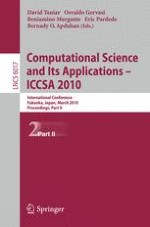2010 | OriginalPaper | Buchkapitel
Efficient Energy Supply from Ground Coupled Heat Transfer Source
verfasst von : Maurizio Carlini, Sonia Castellucci
Erschienen in: Computational Science and Its Applications – ICCSA 2010
Verlag: Springer Berlin Heidelberg
Aktivieren Sie unsere intelligente Suche, um passende Fachinhalte oder Patente zu finden.
Wählen Sie Textabschnitte aus um mit Künstlicher Intelligenz passenden Patente zu finden. powered by
Markieren Sie Textabschnitte, um KI-gestützt weitere passende Inhalte zu finden. powered by
The increasing demands of Energy for industrial production and urban facilities, asks for new strategies for Energy sources. In recent years an important problem is to have some energy storage, energy production and energy consumption which fulfill some environment friendly expectations. Much more attention has been recently devoted to renewable energies [1]. Among them energy production from geothermal sources has becoming one of the most attracting topics for Engineering applications. Ground coupled heat transfer might give an efficient energy supplies for well-built construction. At a few meters below the earth’s surface the underground maintains a constant temperature in a approximation through the year allowing to withdraw heat in winter to warm up the habitat and to surrender heat during summer to refresh it. Exploiting this principle, heat exchange is carried out with heat pumps coupled with vertical ground heat exchanger tubes that allows the heating and refreshing of the buildings utilising a single plant installation. This procedure ensure a high degree of productivity, with a moderate electric power requirement compared to performances. In geographical area characterize by specific geological conformations such as the Viterbo area which comprehend active volcanic basins, it is difficult to use conventional geothermal plants. In fact the area presents at shallow depths thermal falde ground water with temperatures that varies from 40 to 60
o
C geothermal heat pumps cannot be utilized [2]. In these area the thermal aquifer can be exploited directly as hot source using vertical heat exchanger steel tubes without altering the natural balance of the basin. Through the heat exchange that occurs between the water in the wells and the fluid that circulates inside the heat exchanger, you can take the heat necessary to meet the needs. The target of the project is to analyze in detail the plant for the exchange of heat with the thermal basin, defining the technical-scientific elements and verifying the exploitation of heat in the building-trade for housing and agricultural fields.
